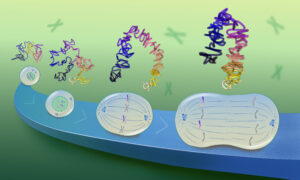
EMBL provides key infrastructure for COVID-19 drug screening project
EMBL Hamburg’s integrated structural biology facility has contributed to the success of a large-scale SARS-CoV-2 study

Scientists from EMBL research groups and EMBL facilities have participated in a wide-reaching collaboration, studying the main protease of SARS-CoV-2. The collaboration, led by Deutsches Elektronen-Synchrotron (DESY) and Universität Hamburg, involved more than 100 researchers affiliated with 30 universities, institutes, and companies. The scientists screened the main SARS-CoV-2 protease against two repurposing libraries, to identify compounds binding to the protease that could inform the development of treatments for COVID-19.
By assessing the potential of existing drugs, researchers hope to see if these drugs can be repurposed to work against SARS-CoV-2. Compared with identifying entirely new compounds, which would have to undergo potentially lengthy characterisation and trials, this approach could save vital time and resources.
Proteases are of particular interest for developing COVID-19 treatments because they represent potential targets for drugs acting against the virus. If the main protease of SARS-CoV-2 could be blocked by a drug, it might be possible to interrupt the cycle of virus replication. While there has been much focus on the creation of vaccines, the development of therapeutics is also an essential part of the fight against COVID-19, being especially important for those with compromised immunity, for whom vaccines offer little protection.
Using a high-throughput screening approach, the scientists tested almost 6,000 known active compounds. This involved using structural biology methods to see – on an atomic scale – how and where drug molecules bind to the protease. The study found 37 compounds that bind to the main protease of SARS-CoV-2, seven of which inhibit the activity of the protein and so could potentially slow down the replication of the virus. Two of those substances proved so effective as to warrant further investigation in preclinical trials.
EMBL’s involvement began in March 2020, shortly after the COVID-19 pandemic forced the closure of the Heidelberg and Hamburg sites. DESY had asked whether EMBL Hamburg could support the project with its beamlines for structure determination, and its Sample Preparation and Characterisation (SPC) Facility for biophysical characterisation. After devising safe operating procedures and obtaining approval from EMBL leadership, the Hamburg site was quickly able to return its P13 and P14 beamlines and the SPC Facility to production.
Once the beamlines were up and running again, samples were delivered using a contactless method. The samples were introduced into robotic sample changers, followed by data collection via remote control, reducing to an absolute minimum the number of people needing to be physically present. Using both P13 and P14, researchers collected data on more than 1,000 crystals, contributing important structural information to the wider screening efforts.

While the beamlines were used to identify compounds binding to the SARS-CoV-2 main protease, the SPC Facility contributed instrumentation and expertise to help the scientists understand how the compounds and the target protein interact. Maria Garcia Alai, Head of the SPC Facility, explains how a desire to make a positive contribution during the pandemic led to rapidly adapting existing ways of working. “We had to move fast to keep staff safe, and at the same time we felt a responsibility to react in support of efforts to tackle the pandemic. We focused on validating the interactions between the protease and the bound compounds observed in the crystals, to ensure the findings are relevant to physiological conditions.”
Thomas Schneider, Joint Head of Research Infrastructures at EMBL Hamburg, reflects on those early, uncertain days. “It was not an easy decision to reopen a locked-down facility when we were all in a state of shock,” he says. “Relying on the competence and dedication of all involved – engineers, scientists, technicians, administration – we were able to go for it and to contribute to the screening study. Later on, the lessons learned helped us implement safe and efficient procedures for running our services during the many subsequent months of the pandemic situation.”
EMBL has a long tradition of making its scientific services and infrastructure available to researchers in EMBL member states and beyond. This large collaboration was made possible in part because of the unique collection of skills and facilities in Hamburg. “It was thanks to a very wide range of skills – including molecular biology, biochemistry, structural biology, biophysics, and beamline operation across institutions – that this study was possible. And, of course, it’s also thanks to open-minded people being generous with their time in the face of such a terrible challenge,” explains Thomas.
This large-scale project shows the value that EMBL services provide to external researchers, and comes at a time when there is an urgent need for faster development of drugs to fight SARS-CoV-2. This and other successful COVID-19-related projects have underlined EMBL’s contribution to the life sciences in Europe, and highlight the effectiveness of EMBL’s collaborative spirit of research.


